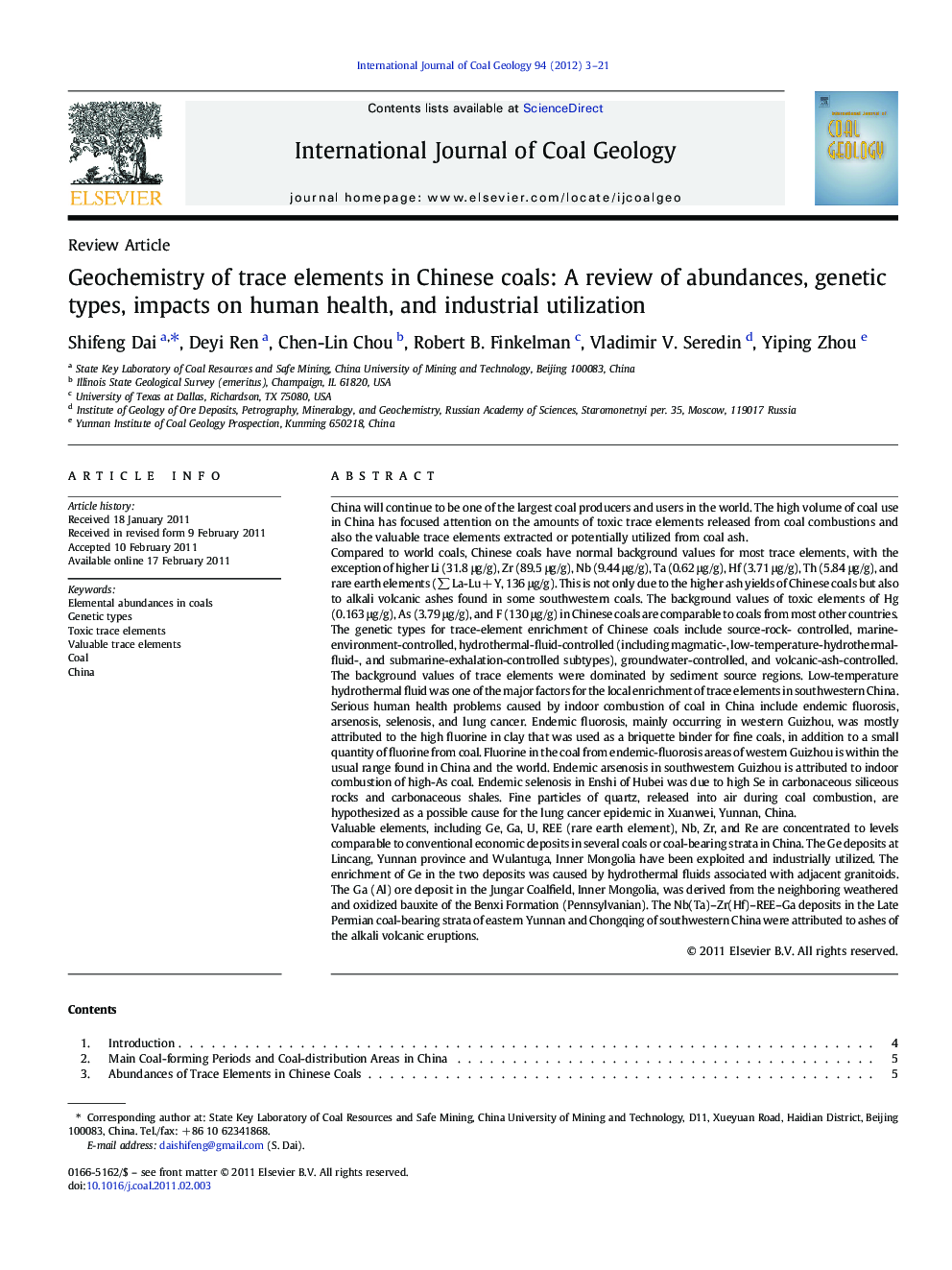| کد مقاله | کد نشریه | سال انتشار | مقاله انگلیسی | نسخه تمام متن |
|---|---|---|---|---|
| 1753640 | 1522599 | 2012 | 19 صفحه PDF | دانلود رایگان |

China will continue to be one of the largest coal producers and users in the world. The high volume of coal use in China has focused attention on the amounts of toxic trace elements released from coal combustions and also the valuable trace elements extracted or potentially utilized from coal ash.Compared to world coals, Chinese coals have normal background values for most trace elements, with the exception of higher Li (31.8 μg/g), Zr (89.5 μg/g), Nb (9.44 μg/g), Ta (0.62 μg/g), Hf (3.71 μg/g), Th (5.84 μg/g), and rare earth elements (∑ La-Lu + Y, 136 μg/g). This is not only due to the higher ash yields of Chinese coals but also to alkali volcanic ashes found in some southwestern coals. The background values of toxic elements of Hg (0.163 μg/g), As (3.79 μg/g), and F (130 μg/g) in Chinese coals are comparable to coals from most other countries.The genetic types for trace-element enrichment of Chinese coals include source-rock- controlled, marine-environment-controlled, hydrothermal-fluid-controlled (including magmatic-, low-temperature-hydrothermal-fluid-, and submarine-exhalation-controlled subtypes), groundwater-controlled, and volcanic-ash-controlled. The background values of trace elements were dominated by sediment source regions. Low-temperature hydrothermal fluid was one of the major factors for the local enrichment of trace elements in southwestern China.Serious human health problems caused by indoor combustion of coal in China include endemic fluorosis, arsenosis, selenosis, and lung cancer. Endemic fluorosis, mainly occurring in western Guizhou, was mostly attributed to the high fluorine in clay that was used as a briquette binder for fine coals, in addition to a small quantity of fluorine from coal. Fluorine in the coal from endemic-fluorosis areas of western Guizhou is within the usual range found in China and the world. Endemic arsenosis in southwestern Guizhou is attributed to indoor combustion of high-As coal. Endemic selenosis in Enshi of Hubei was due to high Se in carbonaceous siliceous rocks and carbonaceous shales. Fine particles of quartz, released into air during coal combustion, are hypothesized as a possible cause for the lung cancer epidemic in Xuanwei, Yunnan, China.Valuable elements, including Ge, Ga, U, REE (rare earth element), Nb, Zr, and Re are concentrated to levels comparable to conventional economic deposits in several coals or coal-bearing strata in China. The Ge deposits at Lincang, Yunnan province and Wulantuga, Inner Mongolia have been exploited and industrially utilized. The enrichment of Ge in the two deposits was caused by hydrothermal fluids associated with adjacent granitoids. The Ga (Al) ore deposit in the Jungar Coalfield, Inner Mongolia, was derived from the neighboring weathered and oxidized bauxite of the Benxi Formation (Pennsylvanian). The Nb(Ta)–Zr(Hf)–REE–Ga deposits in the Late Permian coal-bearing strata of eastern Yunnan and Chongqing of southwestern China were attributed to ashes of the alkali volcanic eruptions.
Journal: International Journal of Coal Geology - Volume 94, 1 May 2012, Pages 3–21